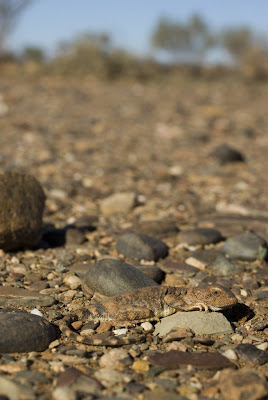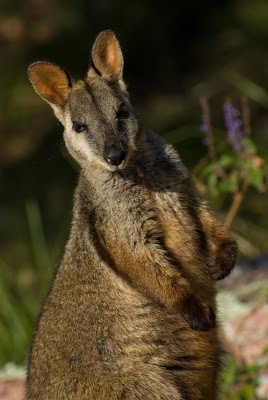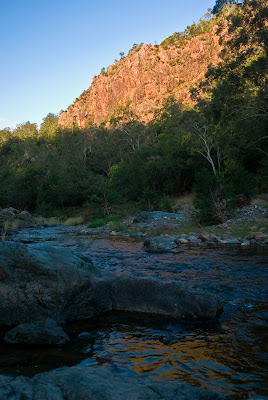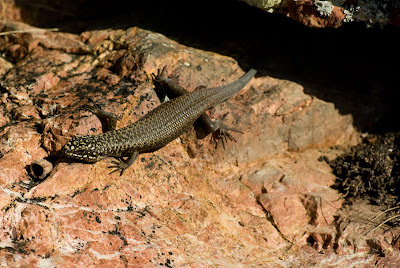Hey guys, I'm currently on the road, living out of my car and driving around Australia. Check out my adventures here
Wednesday, December 03, 2008
Sunday, October 05, 2008
What happened?
I'm going to put this out as a reader challenge while I do some research myself. I came across this somewhat disturbing spectacle in a local bit of bushland. The spider (which was on a vertical trunk as it happens) appears to be a huntsman which has been/is being consumed by some sort of parasitic fungus. It certainly makes me shudder. Apologies for the photo quality, I only had my happy snap camera with me at the time.


Tuesday, September 30, 2008
Assorted Simpson desert photos
I mentioned that I've done a bit of volunteer work in the Simpson recently - without further ado, here are a selection of photos. Remember to check out the rest of the album for any photos I've deemed less... publishable!
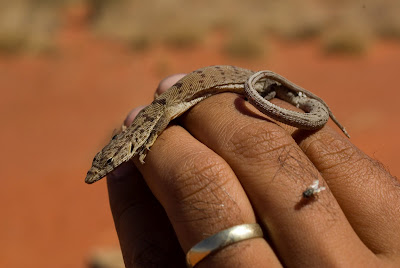
Varanus gilleni, Pygmy mulga monitor
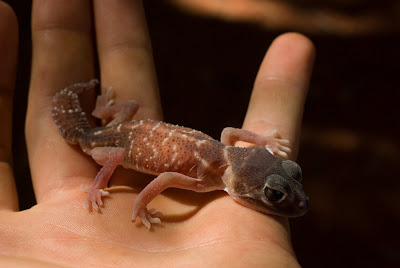
Nephrurus laevis, Knob-tailed gecko
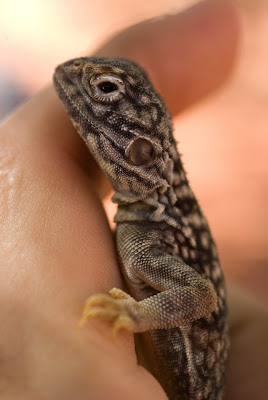
Ctenophorus nuchalis, Central netted dragon

Morethia ruficauda, Fire-tailed skink

Ctenotus pantherinus, Panther skink
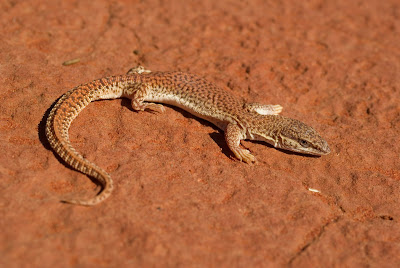
Varanus brevicauda, Short-tailed pygmy monitor - smallest monitor in the world
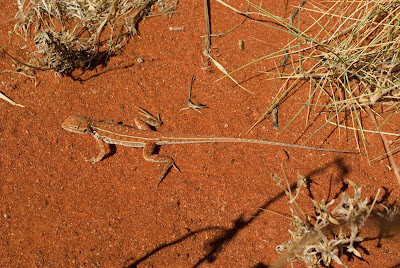
Ctenophorus isolepis - Military dragon
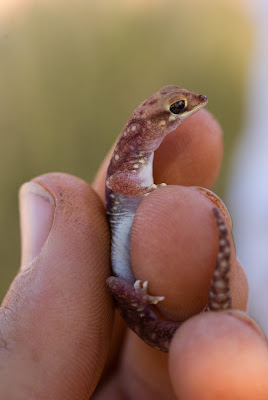
Rhynchoedura ornata - Beaked Gecko
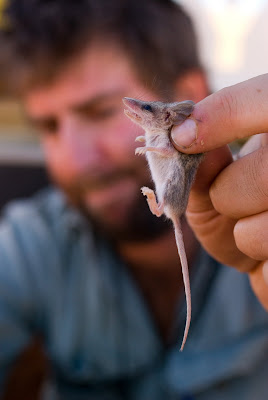
Ningaui rideii
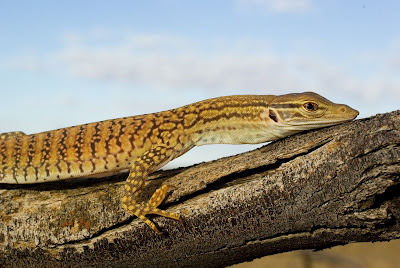
Varanus gouldii, Gould's sand goanna
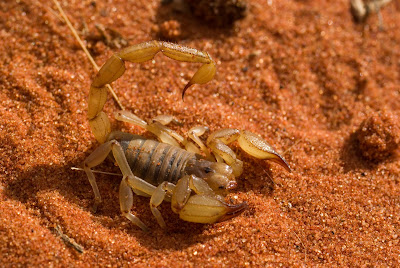
Scorpion
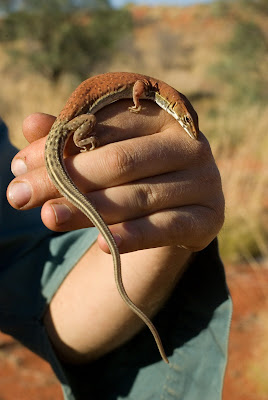
Varanus eremius, Spinifex goanna
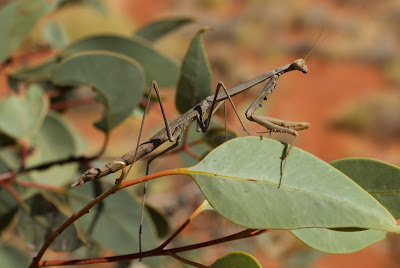
Mantid

Sand tracks - lizard
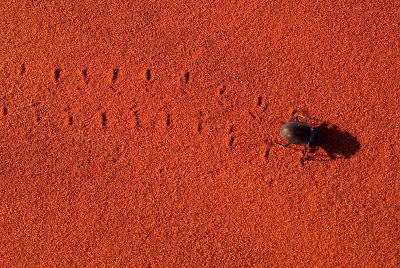
Tenebrionid & tracks
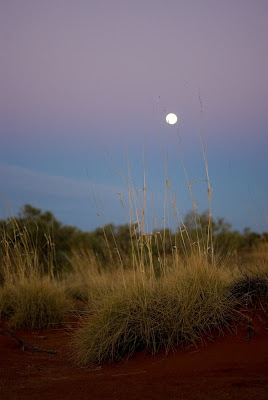
Moon and spnifex clump
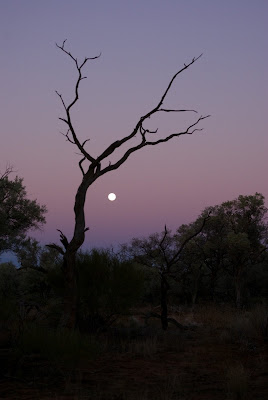
Moonrise in the Gidgee
Varanus gilleni, Pygmy mulga monitor
Nephrurus laevis, Knob-tailed gecko
Ctenophorus nuchalis, Central netted dragon
Morethia ruficauda, Fire-tailed skink
Ctenotus pantherinus, Panther skink
Varanus brevicauda, Short-tailed pygmy monitor - smallest monitor in the world
Ctenophorus isolepis - Military dragon
Rhynchoedura ornata - Beaked Gecko
Ningaui rideii
Varanus gouldii, Gould's sand goanna
Scorpion
Varanus eremius, Spinifex goanna
Mantid
Sand tracks - lizard
Tenebrionid & tracks
Moon and spnifex clump
Moonrise in the Gidgee
Monday, September 29, 2008
Curracabundi
I was recently lucky enough to visit Curracabundi National Park - located out past Gloucester near Nowendoc. The park has been acquired fairly recently, largely for its value as a stronghold for the endangered Brush-tailed Rock Wallaby. I was on a trip studying this species so got to get some great looks at them and spend some time observing and photographing a colony. As always there were lots of other interesting things to see.
N.B. I'm experimenting with a different system of posting images whereby I upload a picasa web album (in this case 17 images) and then embed a selection of the best photos in the blog post itself. Each image you see will link to the photo in the album, from where you can view the rest of the photos. I'm trying this out as a way of making more photos available for viewing - not just the best ones that I want to put in a post. Let me know if you like/dislike/have problems with the system.
N.B. I'm experimenting with a different system of posting images whereby I upload a picasa web album (in this case 17 images) and then embed a selection of the best photos in the blog post itself. Each image you see will link to the photo in the album, from where you can view the rest of the photos. I'm trying this out as a way of making more photos available for viewing - not just the best ones that I want to put in a post. Let me know if you like/dislike/have problems with the system.

Greenhood
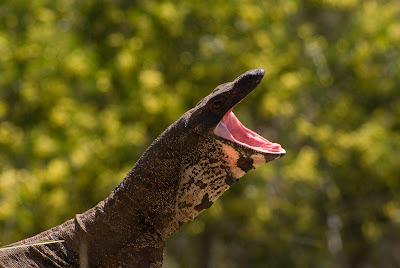
Lace Monitor, Varanus varius - this big animal was causing some consternation amongst the rock wallabies.

Brush-tailed Rock Wallabies with pouch joey
Rock wallabies spend their days on rocky outcrops, often basking in the sun and squabbling over the best positions on the rocks. When evening comes the wallabies venture out from their refugia to feed.
Tuesday, September 02, 2008
Monday, July 28, 2008
Monday, July 21, 2008
Simpson desert trip highlight
Tuesday, July 08, 2008
Simpson Desert part 2: Frogs!
I've just got back after another trip into the Simpson. Luckily there was a bit of rain out there before we arrived which resulted in a couple of frogs being active!

The first I found on the trip out there when we stopped for the night - between Nyngan and Bourke. It's Neobatrachus sudelli, the Painted Burrowing Frog. I could hear frogs calling but they were a long way off.
In the Simpson there was only about 15 mm, enough to wet the sand but not enough to fill clay pans where frogs would breed. I searched at night but it was actually thanks to our pitfall traps that we caught two frogs.

One was the beautiful Notaden nichollsi, the Desert Spadefoot Toad (a close relative of N. bennetti, the Holy Cross Toad). Of course these frogs aren't real toads, but rather ground frogs in the Myobatrachid family.

The other was a Neobatrachus species like the first I saw, but it's N. centralis this time, the Trilling Frog. Check out the vertical pupil!

These desert frogs are all burrowers - they dig downwards through the sand and sit out the dry periods. With a bit of rain they surface, feed (largely on termites and ants), breed if they can, then dig themselves back under the sand to wait.
I was very happy to see these gorgeous little frogs - there are many desert adapted species in Australia that I've heard a lot about but this was the first time I'd seen any.

The first I found on the trip out there when we stopped for the night - between Nyngan and Bourke. It's Neobatrachus sudelli, the Painted Burrowing Frog. I could hear frogs calling but they were a long way off.
In the Simpson there was only about 15 mm, enough to wet the sand but not enough to fill clay pans where frogs would breed. I searched at night but it was actually thanks to our pitfall traps that we caught two frogs.

One was the beautiful Notaden nichollsi, the Desert Spadefoot Toad (a close relative of N. bennetti, the Holy Cross Toad). Of course these frogs aren't real toads, but rather ground frogs in the Myobatrachid family.

The other was a Neobatrachus species like the first I saw, but it's N. centralis this time, the Trilling Frog. Check out the vertical pupil!

These desert frogs are all burrowers - they dig downwards through the sand and sit out the dry periods. With a bit of rain they surface, feed (largely on termites and ants), breed if they can, then dig themselves back under the sand to wait.
I was very happy to see these gorgeous little frogs - there are many desert adapted species in Australia that I've heard a lot about but this was the first time I'd seen any.
Thursday, June 05, 2008
Broad headed snakes rock on

I've just been out at Yengo helping a fellow student with some field work - you can read about the project in today's Sydney Morning Herald article here. It was a real treat to see my first broad-head (Hoplocephalus bungaroides): this one was nestled in a rock crevice.

Another highlight was this Thick tailed (or Barking) gecko (Underwoodisaurus milli) which we found under a piece of tin. He put on this impressive threat display and even barked and lunged at me a few times as I took his picture.
Thursday, May 29, 2008
Trip report: Simpson desert, part 1

Back in April, immediately after handing in my thesis, I bought myself a swag and headed out to the Simpson desert. I was a volunteer on a trip run by the "Dickman Lab" aka the Institute of Wildlife Research at Sydney Uni. This group of researchers carries out a range of ecological studies in the arid zone, from the effects of feral cats and foxes, fire ecology, population dynamics and the effects of grazing. Chris Dickman has been leading research the particular study area that I was visiting in the Simpson for around 20 years.

It was great to see the country change - dry up - flatten out - as we headed out of Sydney, through the mountains and across the western plains. Through Bourke, Cunnamulla, Charleville, Windorah and Bedourie. Lying under the starry sky on the first night, just over the NSW-Queensland border, I could feel the tension of weeks in front of a computer in the city slide off me.
Highlights of the drive:
- first nights under the stars
- Mulga (King brown) snake on the road (above)
- channel country
- Wedge-tailed eagle nest (below)

After two and a half days on the road we had arrived!
Tuesday, May 27, 2008
Miscellaneous update
Assuming there are still some people that either subscribe or occasionally check this blog for updates, I thought I'd provide a brief rundown of my activities recently.
Honours is all handed in and I'm awaiting my mark. My vague ambition for the next year or so is to see as much of Australia as possible (road trip!), do some volunteer work, and maybe think about what I want to do next (PhD? Work? Continue avoiding either?).
Since handing in I've been on some field trips - to the Simpson desert, the Warrumbungles and out to Wellington caves. I'll post some photos from the desert along with some comments in the near future.
I also have a backlog of photos (e.g. from the top end and some frogging trips here in Sydney) that I may get around to posting.
Honours is all handed in and I'm awaiting my mark. My vague ambition for the next year or so is to see as much of Australia as possible (road trip!), do some volunteer work, and maybe think about what I want to do next (PhD? Work? Continue avoiding either?).
Since handing in I've been on some field trips - to the Simpson desert, the Warrumbungles and out to Wellington caves. I'll post some photos from the desert along with some comments in the near future.
I also have a backlog of photos (e.g. from the top end and some frogging trips here in Sydney) that I may get around to posting.
Wednesday, February 27, 2008
Coat of many colours

I'm back in Sydney! I have lots of photos from the top end that I'll probably throw up from time to time, though I'm rather busy for the moment with uni work.
Almost immediately after getting back I went for a trip up to the mid-north coast. On the way, picnicing at Karuah, I spotted this lovely moth.
A quick look on Don Herbison-Evans' site revealed what it was - Agarista agricola, 'Joseph's coat moth' (Noctuidae).
This one is a male - and it was very flighty though always returned to this creeper (I assume a food plant). It finally stayed put and I snuck up with guerilla stealth. A fraction of a second after I took this shot it was suddenly off again - this time because a female had turned up and he was in pursuit!
The pair fluttered around for a while though the female seemed to show no interest in her suitor. She did however lead me to another food plant in the area.
This vine was almost entirely defoliated, and I spotted the caterpillar below as well as a few of the same species that had only hatched recently.
Not great photos, happy-snaps only, though I was very impressed with the colouration on both the adult and the larval forms.

Friday, February 01, 2008
Night Tiger
Monday, January 28, 2008
Big, scary arthropods
Subscribe to:
Posts (Atom)


